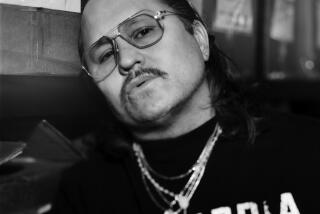Review: How photographer Roy DeCarava captured daily life with aching beauty
“The Work of Art” seems a benign, generic title for any exhibition. As applied to the stirring Roy DeCarava show at the Underground Museum, its meaning reverberates beyond simple description, prompting us to consider not just the objects in question but the practice involved in their making. It invites us to tilt the emphasis from work as a noun to work as a verb.
DeCarava’s work as a photographer was a matter of steady immersion and acute observation. It was an everyday act, and it was personal, a ritual not that different from prayer in its assertion of purposeful connection between individual and wider world.
The show includes about 50 black-and-white photographs spanning 1949 to 2000, with the greatest concentration made in the 1950s, ’60s and ’70s. Wendy DeCarava, the artist’s daughter, served as curator, representing the breadth of her father’s career thoughtfully and with concision, focusing on his chief areas of interest: the streets, the home and jazz.
Born in Harlem, DeCarava (1919-2009) initially studied painting and printmaking. He brought to photography, which he adopted in the mid-’40s, an exquisitely attuned sense of composition and tonal finesse. Any number of images in the show demonstrate DeCarava’s capacity to find and articulate a profound poetry in ordinary life.
“Lingerie” (1950), a view of four boys hanging out on the steps and emergency escape of adjacent New York brownstones, ticks with the precision of a fine watch. The boys, sitting on banisters and leaning off ledges, occupy the cardinal directions of the print, their gestures, glances and white shirts against the charcoal facade beating a circular rhythm around the page, the rhythm of an hour, a day, a world.
Velvety tones in subtle gradation, punctuated by deep, inky blacks and selective gleams of white, are characteristic of DeCarava, whether his subject is a quotidian still life, the stack of dirty dishes at a vacated table or Billie Holiday, tightly framed in performance, face clenched with intensity. His pictures are equally documents and acts of devotion. They register the oscillation between private interior and visible surface, between the sensual and the social.
DeCarava’s work gets introduced in the context of his time and community in “Soul of a Nation: Art in the Age of Black Power 1963-1983,” now at the Broad, a vital complement to the Underground Museum’s achingly beautiful show.
The Underground Museum, 3508 W. Washington Blvd., L.A. Wednesdays-Sundays, through June 30. (323) 989-9925 and www.theunderground-museum.org
Support our coverage of local artists and the local arts scene by becoming a digital subscriber.
See all of our latest arts news and reviews at latimes.com/arts.
More to Read
The biggest entertainment stories
Get our big stories about Hollywood, film, television, music, arts, culture and more right in your inbox as soon as they publish.
You may occasionally receive promotional content from the Los Angeles Times.










